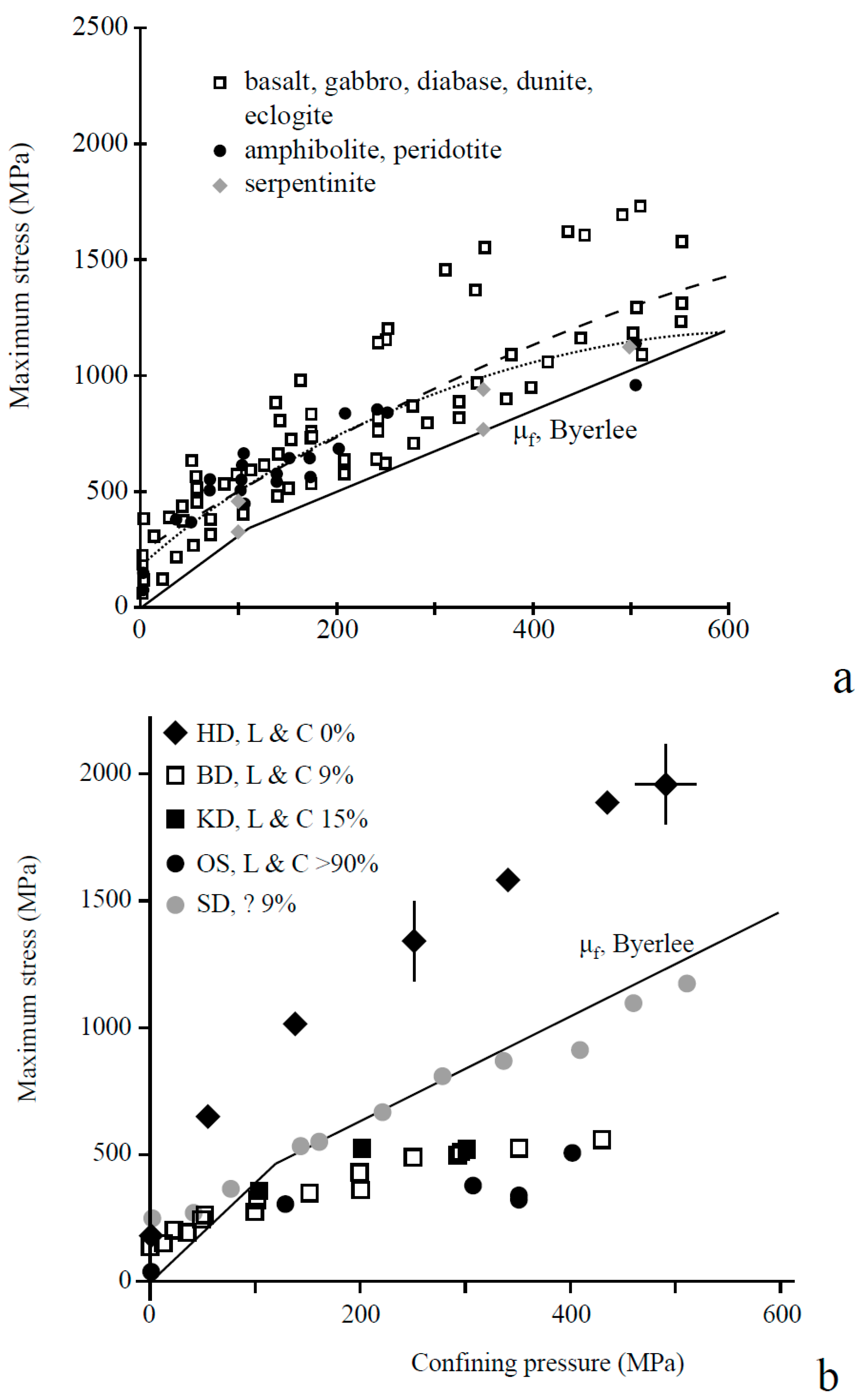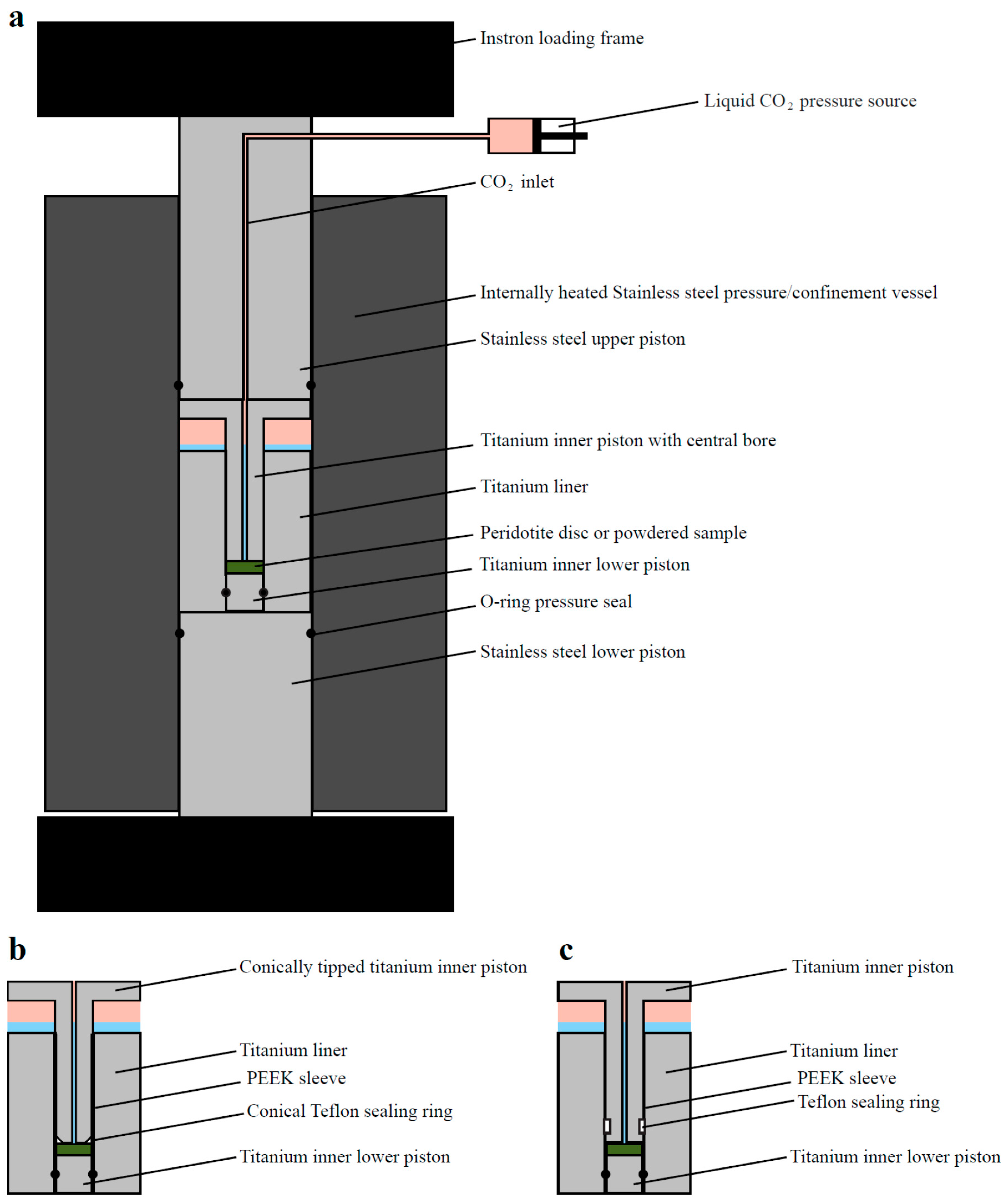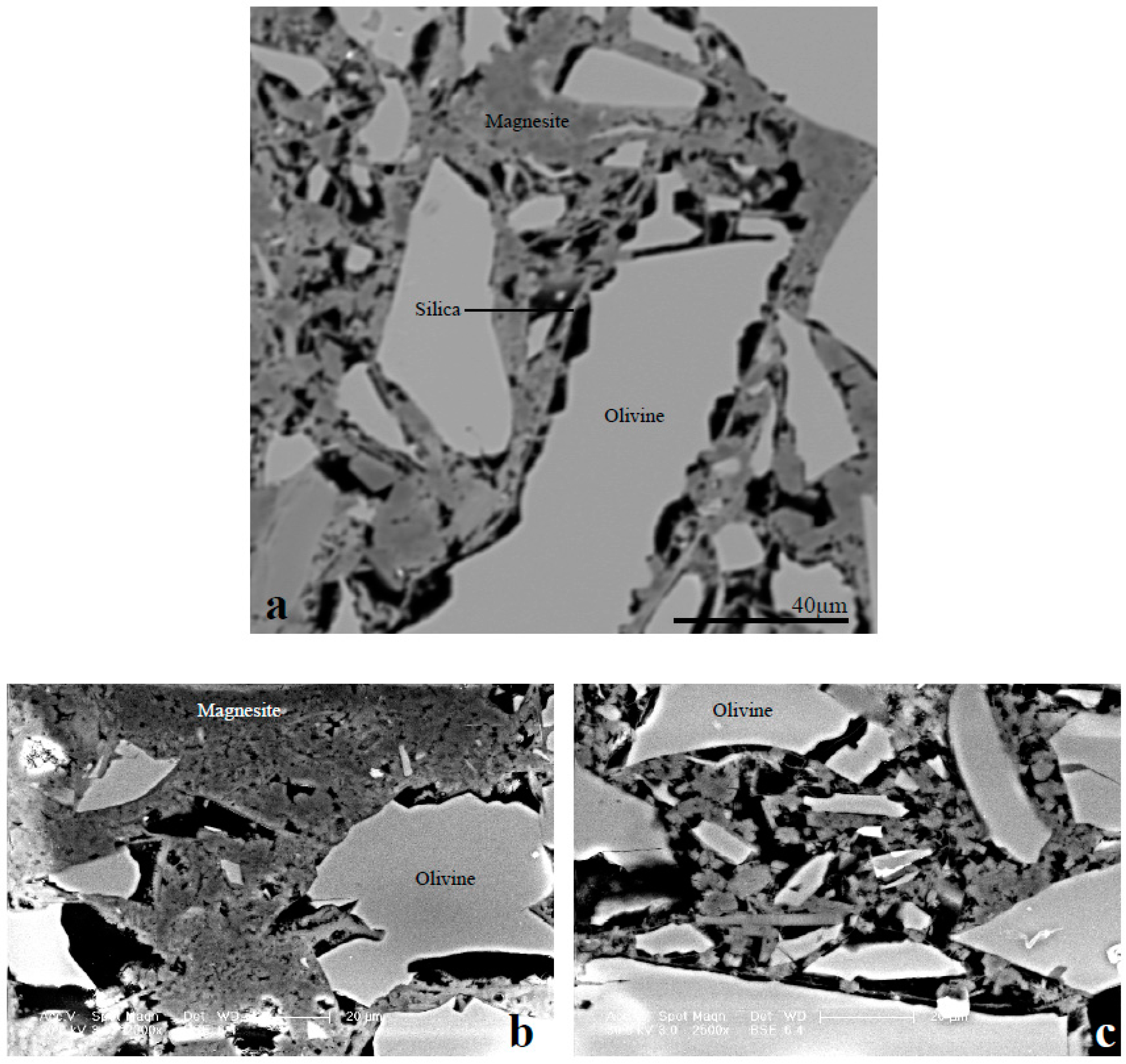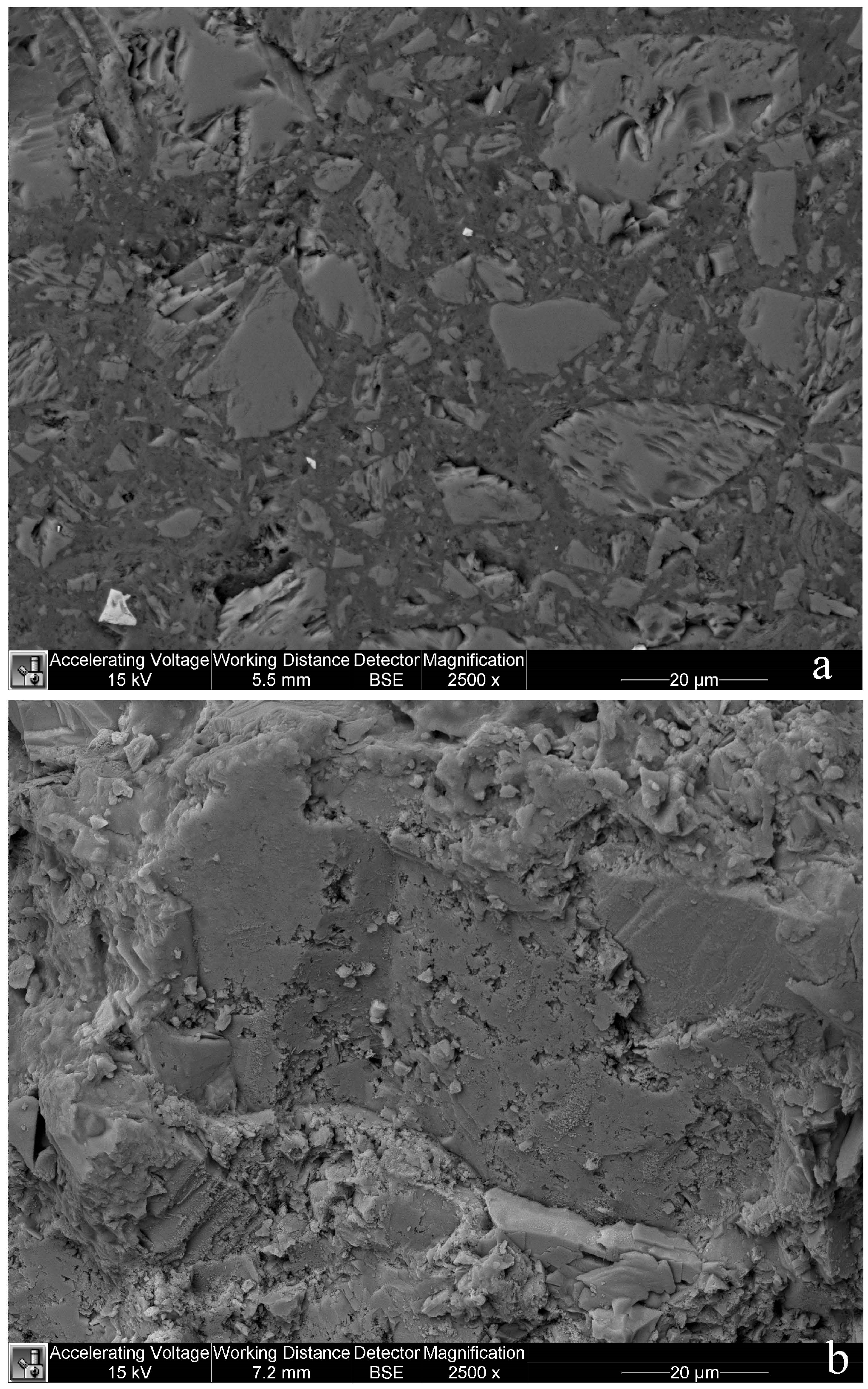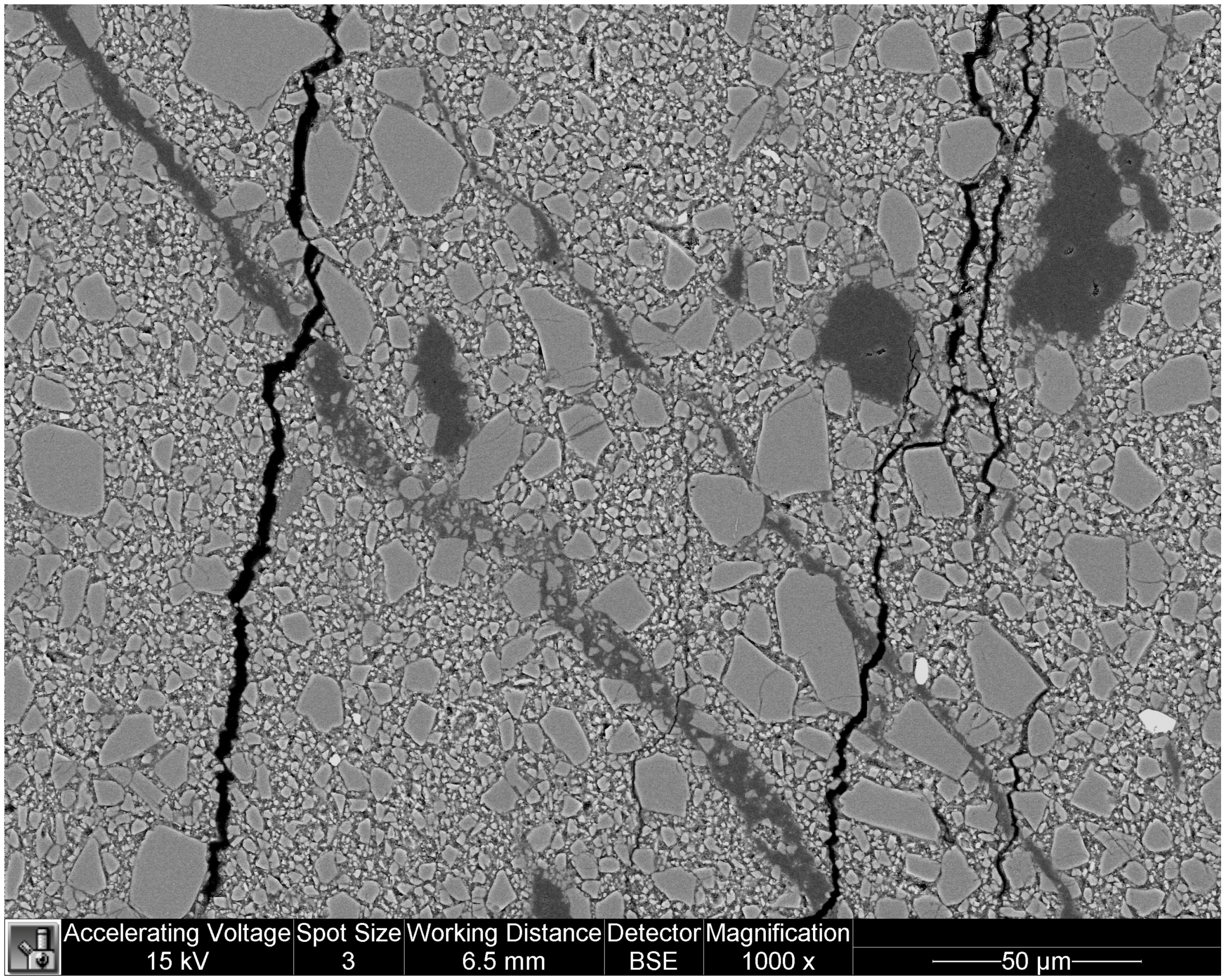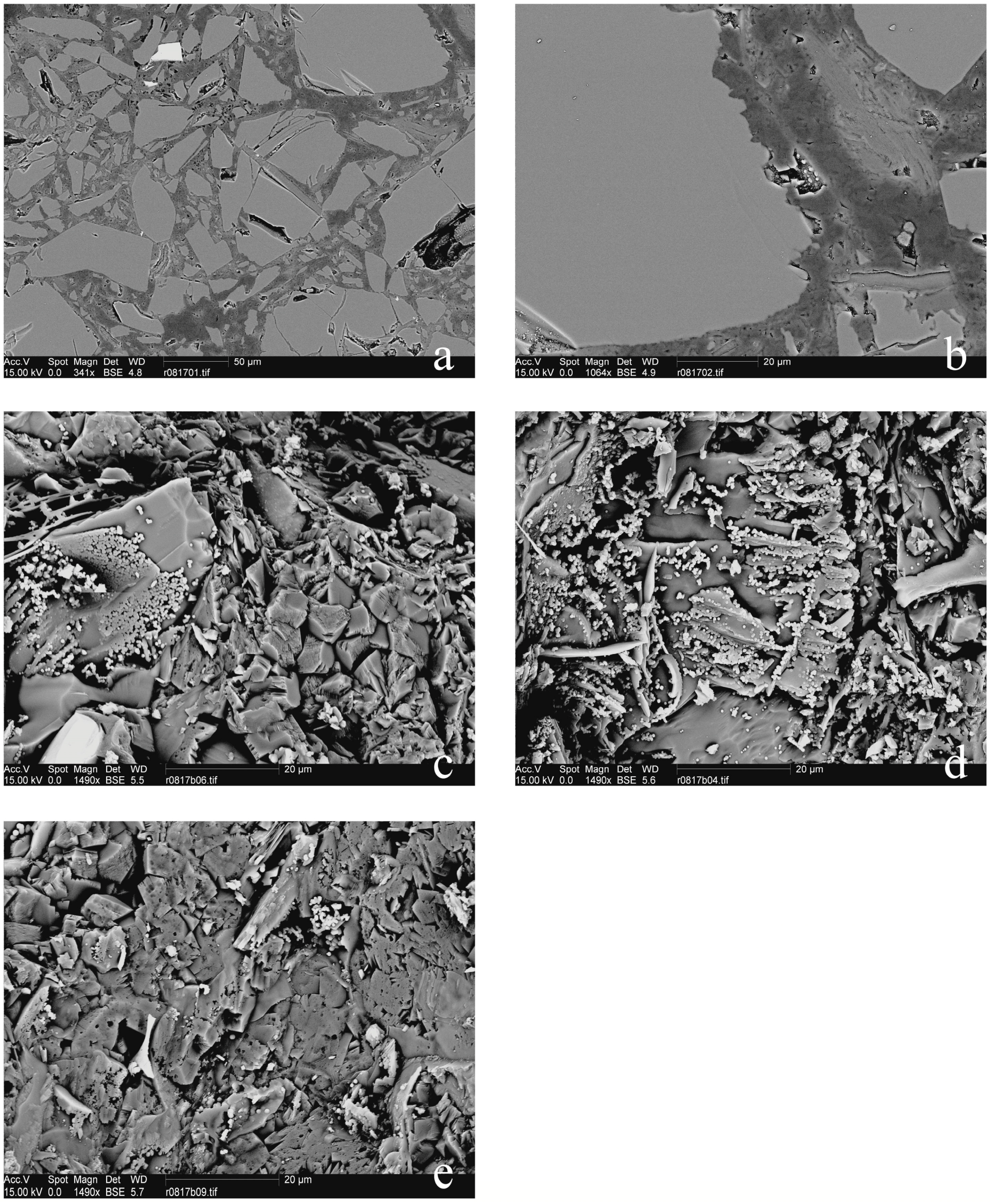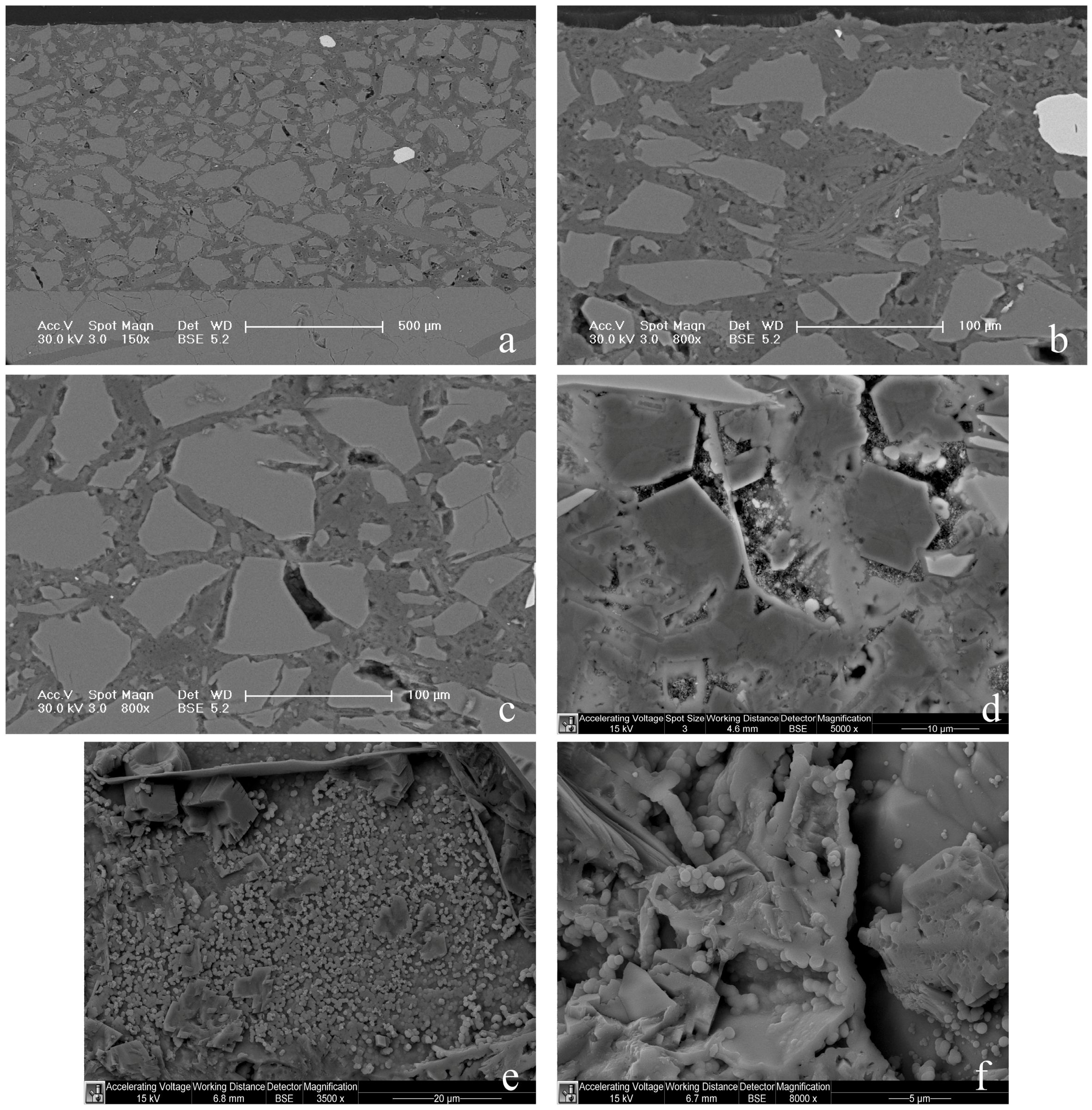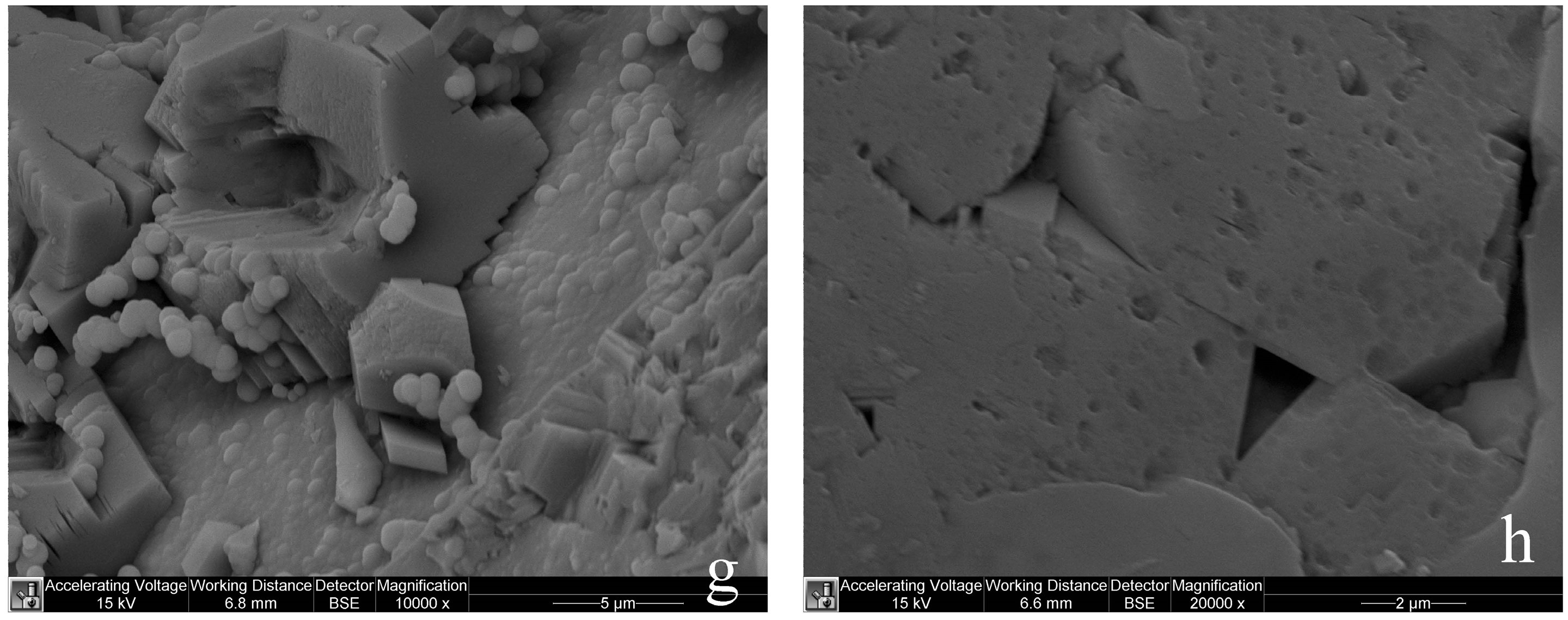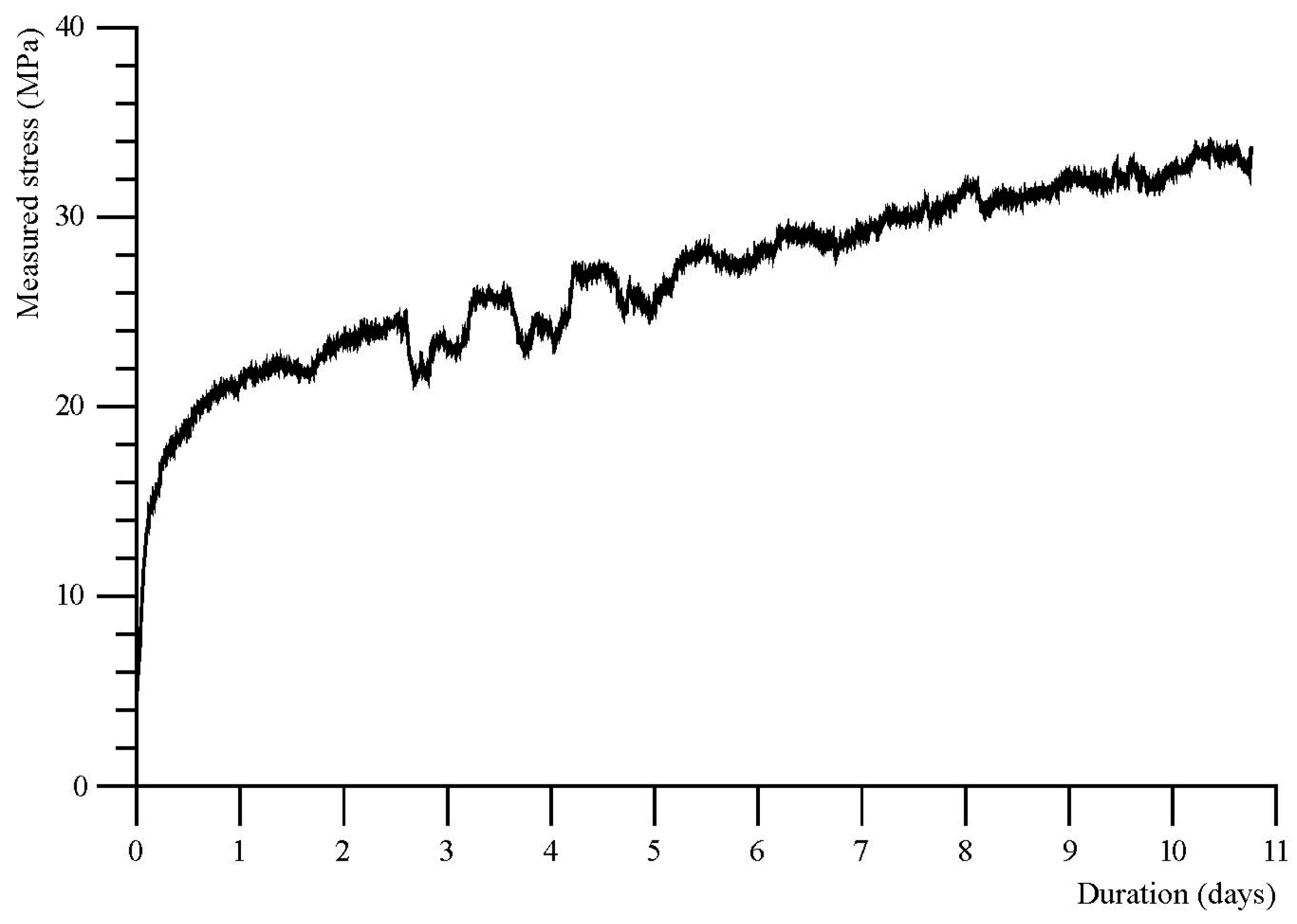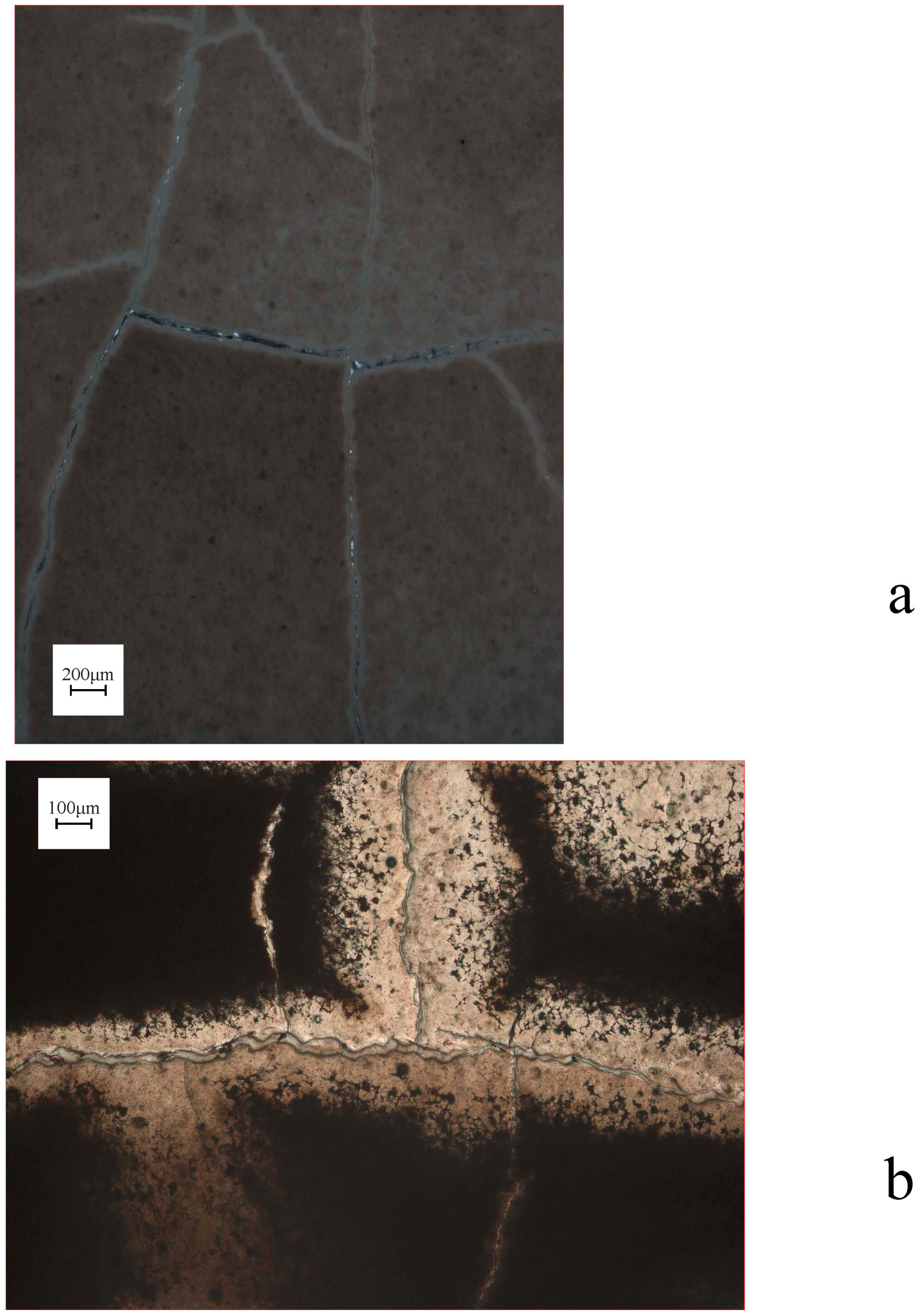Figure 1.
(
a) Shear failure data for various ultramafic and mafic rocks with representative curves and a failure envelope based on Byerlee’s law (with μ = 0.85 and
S0 = 0 at low confining pressure, and μ = 0.6 and
S0 = 50 MPa at higher confining pressure) (figure from [
32]), plus shear failure data for (antigorite-chrysotile) serpentinites (from [
33]). (
b) Shear failure data for various ultramafic rocks presented by [
28]. Data reported for Horoman Dunite (HD), Balsam Gap Dunite (BD), Kükes Dunite, oceanic serpentinite (OS), and Spruce Pine Dunite (SD). L and C are the serpentine phases Lizardite and Chrysotile, ? is an unreported phase (figure from [
28]).
Figure 1.
(
a) Shear failure data for various ultramafic and mafic rocks with representative curves and a failure envelope based on Byerlee’s law (with μ = 0.85 and
S0 = 0 at low confining pressure, and μ = 0.6 and
S0 = 50 MPa at higher confining pressure) (figure from [
32]), plus shear failure data for (antigorite-chrysotile) serpentinites (from [
33]). (
b) Shear failure data for various ultramafic rocks presented by [
28]. Data reported for Horoman Dunite (HD), Balsam Gap Dunite (BD), Kükes Dunite, oceanic serpentinite (OS), and Spruce Pine Dunite (SD). L and C are the serpentine phases Lizardite and Chrysotile, ? is an unreported phase (figure from [
28]).
Figure 2.
A simple schematic representation of the setup used in the force of crystallization experiments. (a) The entire apparatus in general, with the titanium liner as used in the initial experiments. (b) The titanium liner, piston and sample assembly as used in experiments R0805–R0808. (c) The titanium liner, piston and sample assembly as used in experiments R0809–R0815. In experiment R0816 a different lower piston, with a fluid inlet, was used. Note that the apparatus is not drawn precisely to scale. The width of the inner piston is 10 mm. The outer width of the titanium liner is 19 mm.
Figure 2.
A simple schematic representation of the setup used in the force of crystallization experiments. (a) The entire apparatus in general, with the titanium liner as used in the initial experiments. (b) The titanium liner, piston and sample assembly as used in experiments R0805–R0808. (c) The titanium liner, piston and sample assembly as used in experiments R0809–R0815. In experiment R0816 a different lower piston, with a fluid inlet, was used. Note that the apparatus is not drawn precisely to scale. The width of the inner piston is 10 mm. The outer width of the titanium liner is 19 mm.
Figure 3.
The change in stress on sample R0803 vs. time, after correction for changes in CO2-pressure.
Figure 3.
The change in stress on sample R0803 vs. time, after correction for changes in CO2-pressure.
Figure 4.
Microprobe (a) and SEM (b,c) images of reacted powder sample R0801. All images show a framework of olivine grains, with magnesite precipitating as very small grains and rough grain aggregates in the free pore space and on the olivine grain surfaces. In (a), notice the dissolution of olivine behind the precipitated layer of magnesite and silica (lighter areas in the precipitated layer) on the olivine grain surface, suggesting that dissolution continued after this layer was precipitated on the original grain surface. Images (b,c) show representative microstructures from the top and the bottom of the sample respectively, illustrating that magnesite precipitation was more prevalent at the top of the sample, leading to a much lower sample porosity there.
Figure 4.
Microprobe (a) and SEM (b,c) images of reacted powder sample R0801. All images show a framework of olivine grains, with magnesite precipitating as very small grains and rough grain aggregates in the free pore space and on the olivine grain surfaces. In (a), notice the dissolution of olivine behind the precipitated layer of magnesite and silica (lighter areas in the precipitated layer) on the olivine grain surface, suggesting that dissolution continued after this layer was precipitated on the original grain surface. Images (b,c) show representative microstructures from the top and the bottom of the sample respectively, illustrating that magnesite precipitation was more prevalent at the top of the sample, leading to a much lower sample porosity there.
Figure 5.
(a) Polished section SEM BSE micrograph showing a typical microstructure for reacted powder sample R0810. Note the very low porosity of the magnesite cement phase closely surrounding the olivine grains. (b) Fractured surface micrograph of sample R0810, showing very fine-grained magnesite precipitation probably formed along a grain surface.
Figure 5.
(a) Polished section SEM BSE micrograph showing a typical microstructure for reacted powder sample R0810. Note the very low porosity of the magnesite cement phase closely surrounding the olivine grains. (b) Fractured surface micrograph of sample R0810, showing very fine-grained magnesite precipitation probably formed along a grain surface.
Figure 6.
Polished section SEM micrograph showing a typical microstructure for reacted powder sample R0812. A (magnesite) cement phase closely surrounds the (relatively fine) olivine grains, resulting in a very low sample porosity.
Figure 6.
Polished section SEM micrograph showing a typical microstructure for reacted powder sample R0812. A (magnesite) cement phase closely surrounds the (relatively fine) olivine grains, resulting in a very low sample porosity.
Figure 7.
Polished section SEM micrograph showing a typical microstructure for reacted powder sample R0813. Note again the very low sample porosity with a cement phase closely surrounding the olivine grains. Due to sample preparation, R0813 contained some pre-existing cracks which during the experiment were filled with magnesite (dark gray). Open cracks in the sample were caused by removing the sample from the titanium vessel. The larger gray areas in the sample are grains of (hydro-)magnesite that were added to the starting material.
Figure 7.
Polished section SEM micrograph showing a typical microstructure for reacted powder sample R0813. Note again the very low sample porosity with a cement phase closely surrounding the olivine grains. Due to sample preparation, R0813 contained some pre-existing cracks which during the experiment were filled with magnesite (dark gray). Open cracks in the sample were caused by removing the sample from the titanium vessel. The larger gray areas in the sample are grains of (hydro-)magnesite that were added to the starting material.
Figure 8.
(a,b) SEM BSE micrographs of a polished section through the reacted powder layer of sample R0817. Note the very low porosity of the magnesite cement phase closely surrounding the olivine grains. In (b), also note the silica-enriched layer near the dissolving olivine surface (center of image). (c–e) Fractured surface micrographs of sample R0817. (c,d) Silica micro-grains forming sheets along olivine grain surfaces. In (c), also note the ~5 μm cubic magnesite crystals. (e) Growing magnesite crystals ~5 μm in size, with some silica micro-spheres.
Figure 8.
(a,b) SEM BSE micrographs of a polished section through the reacted powder layer of sample R0817. Note the very low porosity of the magnesite cement phase closely surrounding the olivine grains. In (b), also note the silica-enriched layer near the dissolving olivine surface (center of image). (c–e) Fractured surface micrographs of sample R0817. (c,d) Silica micro-grains forming sheets along olivine grain surfaces. In (c), also note the ~5 μm cubic magnesite crystals. (e) Growing magnesite crystals ~5 μm in size, with some silica micro-spheres.
Figure 9.
(a–d) SEM micrographs of a polished thin section of reacted powder sample R0803, showing an overview (a) and close-up images (b–d) of the sample microstructure. Note the very low porosity of the magnesite cement phase closely surrounding the remaining olivine grains. In (d), note the the silica rim (light band) around a now-dissolved olivine grain. (e–h) Fractured surface micrographs. (e,f) Silica micro-grains forming sheets along olivine grain surfaces. (g) A cubic magnesite grain against a silica sheet. Note the (somewhat) open contact between the magnesite and the silica. (h) Magnesite grain boundaries.
Figure 9.
(a–d) SEM micrographs of a polished thin section of reacted powder sample R0803, showing an overview (a) and close-up images (b–d) of the sample microstructure. Note the very low porosity of the magnesite cement phase closely surrounding the remaining olivine grains. In (d), note the the silica rim (light band) around a now-dissolved olivine grain. (e–h) Fractured surface micrographs. (e,f) Silica micro-grains forming sheets along olivine grain surfaces. (g) A cubic magnesite grain against a silica sheet. Note the (somewhat) open contact between the magnesite and the silica. (h) Magnesite grain boundaries.
Figure 10.
Measured reaction-induced vertical stress resulting from the hydration of periclase (MgO) at 165 °C and 17 MPa fluid pressure. The stress given is the effective stress.
Figure 10.
Measured reaction-induced vertical stress resulting from the hydration of periclase (MgO) at 165 °C and 17 MPa fluid pressure. The stress given is the effective stress.
Figure 11.
Photomicrographs of R0901, an aggregate of MgO single crystals, after its hydration under hydrothermal conditions. Fluid interpenetration occurred from the top of the image. (a) Image taken under cross-polarized light, ~4 mm below the top surface of the sample. This image shows the typical hierarchical pattern of reaction fractures that formed in the sample, especially close to the fluid interpenetration front. Note the (thin) reacted rims (lighter colored) along the cracks. (b) Image taken under plane-polarized light, ~1 mm from the top surface of the sample. Note the ~200 μm wide reaction rims (light) along the fractures.
Figure 11.
Photomicrographs of R0901, an aggregate of MgO single crystals, after its hydration under hydrothermal conditions. Fluid interpenetration occurred from the top of the image. (a) Image taken under cross-polarized light, ~4 mm below the top surface of the sample. This image shows the typical hierarchical pattern of reaction fractures that formed in the sample, especially close to the fluid interpenetration front. Note the (thin) reacted rims (lighter colored) along the cracks. (b) Image taken under plane-polarized light, ~1 mm from the top surface of the sample. Note the ~200 μm wide reaction rims (light) along the fractures.
Table 1.
Literature data on uniaxial tensile strength () for peridotite, serpentinite, gabbro and Columbia River Basalts.
Table 1.
Literature data on uniaxial tensile strength () for peridotite, serpentinite, gabbro and Columbia River Basalts.
| Rock | (MPa) | Reference |
|---|
| Baoxing Augite-peridotite | 49.2–284.6 | [27] |
| Serpentinite | 2.3 | [29] |
| Gabbro (gneissic, diorite) | 13.79 | [30] |
| Gabbro | 16.41 | [30] |
| Pyroxenite (fresh) | 22.75 | [30] |
| Pyroxenite (moderately altered) | 18.62 | [30] |
| Pyroxenite (heavily altered) | 13.79 | [30] |
| Pyroxenite (garnet) | 15.17 | [30] |
| Magnesite | 17.1 | [30] |
| Columbia River Basalts | | |
| Grande Ronde. WA. Utanum flow | 11.9 | [31] |
| Grande Ronde. WA. Pomona flow | 19.4 | [31] |
| Grande Ronde. WA. Cohassett flow | 13.6 | [31] |
Table 2.
Literature data on fracture toughness and subcritical crack growth parameters , Δ and for various mafic and ultramafic rocks. and are the temperature and pressure at which measurements were made (RT is room temperature). Presumably, unspecified temperatures are room temperature, and unspecified pressures are atmospheric pressure.
Table 2.
Literature data on fracture toughness and subcritical crack growth parameters , Δ and for various mafic and ultramafic rocks. and are the temperature and pressure at which measurements were made (RT is room temperature). Presumably, unspecified temperatures are room temperature, and unspecified pressures are atmospheric pressure.
| Rock/Mineral | (K) | (Mpa) | MPa·m1/2 | Subcritical Crack Growth Parameters | Reference |
|---|
| Δ(kJ·mol−1) | |
|---|
| Olivine (010) Fo88 | RT | - | 0.59 | - | - | - | [34] |
| Olivine (001) Fo88 | RT | - | 0.73 | - | - | - | [34] |
| Hot-pressed olivine | - | - | 0.65–0.75 | - | - | - | [35] |
| Dunite | - | - | 3.5 | - | - | - | [36] |
| Dunite | RT | - | 3.74 | - | - | - | [37] |
| Serpentinized dunite | RT | - | 1.39 | - | - | - | [37] |
| Black Gabbro (in vacuum) | 293 | 0 | 2.71–3.03 | - | - | - | [37] |
| Black Gabbro (in vacuum) | 373 | 0 | 2.84–3.42 | - | - | - | [37] |
| Black Gabbro (in vacuum) | 473 | 0 | 2.58–3.06 | - | - | - | [37] |
| Black Gabbro (in air) | 293 | 0.1 | - | - | - | 54–58 | [37] |
| Black Gabbro (in water) | 293 | 0.1 | - | - | - | 29–36 | [37] |
| Whin Sill dolerite (in air) | 293 | 0.1 | 3.26–3.32 | - | - | 31 | [37] |
| Whin Sill dolerite (in water) | 293–353 | 0.1 | - | - | 30–46 | 29 | [37] |
Table 3.
Values from the literature for the uniaxial compressive strength (), cohesive shear strength () and internal friction coefficient () of various ultramafic and mafic rocks, including Columbia River Basalts.
Table 3.
Values from the literature for the uniaxial compressive strength (), cohesive shear strength () and internal friction coefficient () of various ultramafic and mafic rocks, including Columbia River Basalts.
| Rock/Mineral | C0 (GPa) | S0 (GPa) | μ | Reference |
|---|
| Forsterite | - | 0.177 | - | [38] |
| Horoman Dunite | - | - | 0.6 | [39] |
| Peridotite (Thetford, Quebec, olivine + pyroxene + serpentine) | 0.197 | - | - | [30] |
| Gabbro (veined) | 0.126 | - | - | [30] |
| Gabbro (gneissic, diorite) | 0.186 | - | - | [30] |
| Gabbro | 0.311 | - | - | [30] |
| Gabbro | 0.317 | - | - | [30] |
| Gabbro | 0.223 | - | - | [30] |
| Gabbro (meta-) | 0.133 | - | - | [30] |
| Pyroxenite (fresh) | 0.182 | - | - | [30] |
| Pyroxenite (moderately altered) | 0.122 | - | - | [30] |
| Pyroxenite (heavily altered) | 0.059 | - | - | [30] |
| Pyroxenite (garnet) | 0.085 | - | - | [30] |
| Magnesite | 0.137–0.234 | - | - | [30] |
| Serpentinized olivine | - | 0.09 | 0.65 | [40] |
| Serpentinite | - | - | 0.3–0.5 | [33] |
| Chrysotile gouge | - | - | 0.2 | [41] |
| Gabbro | - | 0.038 | 0.18–0.66 | [33,36,40] |
| Columbia River Basalts | | | | |
| Grande Ronde, WA, Utanum flow | 0.212 | - | - | [31] |
| Grande Ronde, WA, Pomona flow | 0.356 | - | - | [31] |
| Grande Ronde, WA, Cohassett flow | 0.235 | - | - | [31] |
Table 4.
Literature values for elastic constants for the principal peridotite minerals, and for various ultramafic and mafic rocks. and indicate measurement conditions (RT is room temperature). , , , and are Young’s modulus, Shear modulus, poisson’s ratio, and Bulk modulus, respectively. The temperature derivative of Young’s modulus (d/d) is also given.
Table 4.
Literature values for elastic constants for the principal peridotite minerals, and for various ultramafic and mafic rocks. and indicate measurement conditions (RT is room temperature). , , , and are Young’s modulus, Shear modulus, poisson’s ratio, and Bulk modulus, respectively. The temperature derivative of Young’s modulus (d/d) is also given.
| Rock/Mineral | T (K) | P (MPa) | E (GPa) | G (GPa) | ν | K (GPa) | dE/dT (Gpa/K) | Reference |
|---|
| Olivine (Fo92) | RT | - | 201 | 81 | 0.245 | 131 | −0.03 | [42] |
| Olivine (Fo93) | 298 | - | 197 | 79 | 0.247 | 129 | −0.03 | [42] |
| Olivine (forsterite) | - | - | 216.7 | 86.7 | 0.24 | - | - | [30] |
| Forsterite (Fo100) | 298 | - | 201 | 81 | 0.240 | 129 | −0.03 | [42] |
| Forsterite (Fo100) | 298 | - | 202 | 82 | 0.239 | 129 | −0.03 | [42] |
| Bronzite (En85) | RT | - | 152 | 61 | 0.252 | 102 | - | [42] |
| Dunite (Horoman) | - | - | 150 | 130 | - | - | - | [39] |
| Dunite (New Zealand) | - | - | 152 | 60 | 0.27 | - | - | [30] |
| Dunite (New Zealand) | - | - | 162 | 58 | 0.40 | - | - | [30] |
| Dunite (New Zealand) | - | 400 | 64.7 | - | - | - | - | [30] |
| Dunite (Balsam Gap) | - | 50 | - | 64 | - | - | - | [30] |
| Dunite (Balsam Gap) | - | 400 | - | 67 | - | - | - | [30] |
| Dunite (Balsam Gap) | - | - | 148.4 | 47.6 | - | - | - | [30] |
| Dunite (Balsam Gap) | - | 50 | 65.4 | - | - | - | - | [30] |
| Dunite (Balsam Gap) | - | 400 | 69.4 | - | - | - | - | [30] |
| Dunite (Balsam Gap) | - | - | 68.1 | - | - | - | - | [30] |
| Dunite (Balsam Gap) | - | 400 | 70.6 | - | - | - | - | [30] |
| Dunite (Balsam Gap) | - | 0 | - | - | - | 89.3 | - | [30] |
| Dunite (Balsam Gap) | - | 12 | - | - | - | 91.7 | - | [30] |
| Dunite (Balsam Gap) | - | 60 | - | - | - | 105 | - | [30] |
| Dunite (Balsam Gap) | - | 700 | - | - | - | 127 | - | [30] |
| Dunite (Balsam Gap) | - | 400 | - | - | - | 125 | - | [30] |
| Dunite (Balsam Gap) | - | 400 | - | - | - | 121 | - | [30] |
| Dunite (Twin Sisters) | - | - | 195 | 74 | - | - | - | [30] |
| Dunite (Twin Sisters) | - | - | 140 | 66 | - | - | - | [30] |
| Dunite (Twin Sisters) | - | - | - | 72 | - | - | - | [30] |
| Dunite (Twin Sisters) | - | 400 | - | 75.7 | - | - | - | [30] |
| Dunite (Twin Sisters) | - | 400 | - | - | - | 125 | - | [30] |
| Dunite (Moolhock Mine) | - | - | 50.9 | - | - | - | - | [30] |
| Dunite (Moolhock Mine) | - | 1000 | 57.2 | - | - | - | - | [30] |
| Peridotite (Moncha-Tundra Khibiny) | - | - | 164.76 | - | 0.26 | - | - | [30] |
| Peridotite (Thetford, Quebec, ol + py + serp) | - | - | 55.2 | - | - | - | - | [30] |
| Peridotite (Moncha-Tundra) | - | - | 168 | - | 0.26 | - | - | [30] |
| Peridotite (garnet-peridotite) | - | - | 134.7 | - | 0.24 | - | - | [30] |
| Peridotite (Moncha-Tundra) | - | - | 157 | - | - | - | - | [30] |
| 60% Serpentinized (Oman) Harzburgite | RT | 0–600 | - | - | 0.28–0.32 | - | - | [43] |
| Serpentinite (Korean) | 298 | 0–70 | 60–80 | 20–30 | 0.25–0.3 | 50–60 | - | [44] |
| Serpentinite | - | - | 10.6 | - | - | - | - | [29] |
| “Serpentine“ (Talc schist, Alberene) | - | 200 | - | - | - | 55.9 | - | |
| “Serpentine“ (Talc schist, Alberene) | - | 1000 | - | - | - | 73.5 | - | |
| Lizardite (calculated) | - | - | - | - | - | 68.9 | - | [45] |
| Lizardite (calculated) | - | - | - | - | - | 71 | - | [45] |
| Chrysotile (calculated) | - | - | - | - | - | 62.8 | - | [45] |
| Chrysotile (calculated) | - | - | - | - | - | 54.1 | - | [45] |
| Antigorite (calculated) | - | - | - | - | - | 67.3 | - | [45] |
| Antigorite (calculated) | - | - | - | - | - | 62 | - | [45] |
| Magnesite | - | - | 110 | - | - | - | - | [30] |
| Pyroxene | - | - | 149 | - | - | - | - | [30] |
| Gabbro (altered) | - | - | 84.8 | 33.6 | - | - | - | [46] |
| Gabbro (diabase) | - | - | 119 | 44.1 | - | - | - | [46] |
| Columbia River Basalts | | | | | | | | |
| Grande Ronde, WA, Utanum flow | - | - | 71 | - | 0.27 | - | - | [31] |
| Grande Ronde, WA, Pomona flow | - | - | 83 | - | 0.25 | - | - | [31] |
| Grande Ronde, WA, Cohassett flow | - | - | 70 | - | 0.26 | - | - | [31] |
Table 5.
Changes in free energy and estimated changes in solid volume and total volume for the main reactions expected to occur during peridotite hydration/carbonation at constant temperature. Negative volume changes indicate a volume decrease. Changes in Gibbs free energy are given at standard reference conditions (Δ at 298.15 K and 0.1 MPa) and at 423 K (150 °C) and 50 MPa hydrostatic pressure (~1.5 km depth − Δ ). Volume changes given are changes in solid volume only (Δ ), changes in solid volume without precipitation of silica (Δ ), and changes in total volume, including solids and fluids (Δ ). In the latter case, values are given assuming one-phase flow and two-phase flow. Solid molar volumes are not corrected for temperature and pressure. Fluid molar volumes (for total volume changes) are calculated for a saturated CO2 solution at 423 K and 50 MPa.
Table 5.
Changes in free energy and estimated changes in solid volume and total volume for the main reactions expected to occur during peridotite hydration/carbonation at constant temperature. Negative volume changes indicate a volume decrease. Changes in Gibbs free energy are given at standard reference conditions (Δ at 298.15 K and 0.1 MPa) and at 423 K (150 °C) and 50 MPa hydrostatic pressure (~1.5 km depth − Δ ). Volume changes given are changes in solid volume only (Δ ), changes in solid volume without precipitation of silica (Δ ), and changes in total volume, including solids and fluids (Δ ). In the latter case, values are given assuming one-phase flow and two-phase flow. Solid molar volumes are not corrected for temperature and pressure. Fluid molar volumes (for total volume changes) are calculated for a saturated CO2 solution at 423 K and 50 MPa.
| No. | Reaction | ΔVsolid (%) | ΔVno SiO2 (%) | ΔVtotal (%) |
|---|
| R.1 | Mg2SiO4 + 2CO2 = 2MgCO3 + SiO2 | 84 | 32 | −29/−54 |
| R.2 | 2Mg2SiO4 + 3H2O = Mg3Si2O5(OH)4 + Mg(OH)2 | 58 | - | −5/−5 |
| R.3 | 2Mg2SiO4 + CO2 + 2H2O = Mg3Si2O5(OH)4 + MgCO3 | 63 | - | - |
| R.4 | Mg3Si2O5(OH)4 + 3CO2 = 3MgCO3 + 2SiO2 + 2H2O | 16 | −24 | −22/−45 |
| R.5 | 2Mg3Si2O5(OH)4 + 3CO2 = 3MgCO3 + Mg3Si4O10(OH)2 + 3H2O | −1 | - | - |
| R.6 | Mg(OH)2 + CO2 = MgCO3 + H2O | 16 | - | - |
Table 6.
Free energies of reaction under hydrostatic conditions and maximum effective stress (MPa) generated by confined precipitation in fractures. Calculations were performed assuming either unstressed reactants (outside the confined zone) or stressed reactants (replacement of wallrock in a confined fracture) for the main reactions involved in the carbonation and hydration of peridotite.
Table 6.
Free energies of reaction under hydrostatic conditions and maximum effective stress (MPa) generated by confined precipitation in fractures. Calculations were performed assuming either unstressed reactants (outside the confined zone) or stressed reactants (replacement of wallrock in a confined fracture) for the main reactions involved in the carbonation and hydration of peridotite.
| Reaction | 298.15 K | 315 K | 323 K | 373 K | 423 K | 460 K | 545 K |
|---|
| 0.1 MPa | 50 MPa | 50 MPa | 50 MPa | 50 MPa | 50 MPa | 50 MPa |
|---|
| R.1 | Mg2SiO4 + 2 CO2 = 2 MgCO3 + SiO2 |
| ΔGPT (KJ·mol−1) | −72.831 | −92.350 | −90.732 | −79.949 | −68.148 | −58.857 | −36.032 |
| σne (MPa), reactants unstressed | 925.078 | 1172.995 | 1152.445 | 1015.483 | 865.591 | 747.575 | 457.662 |
| σne (MPa), reactants stressed | 2076.151 | 2632.551 | 2586.430 | 2279.047 | 1942.645 | 1677.782 | 1027.129 |
| R.2 | 2 Mg2SiO4 + 3 H2O = Mg3Si2O5(OH)4 + Mg(OH)2 |
| ΔGPT (kJ·mol−1) | −47.069 | −47.644 | −46.635 | −40.330 | −33.488 | −27.966 | −14.347 |
| σne (MPa), reactants unstressed | 356.233 | 360.584 | 352.948 | 305.230 | 253.447 | 211.652 | 108.580 |
| σne (MPa), reactants stressed | 1049.946 | 1062.768 | 1040.263 | 899.620 | 746.999 | 623.814 | 320.025 |
| R.3 | 2 Mg2SiO4 + CO2 + 2 H2O = Mg3Si2O5(OH)4 + MgCO3 |
| ΔGPT (kJ·mol−1) | −85.857 | −95.901 | −94.372 | −84.484 | −73.728 | −65.184 | −44.193 |
| σne (MPa), reactants unstressed | 633.541 | 707.652 | 696.372 | 623.405 | 544.041 | 480.990 | 326.098 |
| σne (MPa), reactants stressed | 1780.536 | 1988.821 | 1957.121 | 1752.051 | 1529.000 | 1351.800 | 916.484 |
| R.4 | Mg3Si2O5(OH)4 + 3 CO2 = 3 MgCO3 + 2 SiO2 + 2 H2O |
| ΔGPT (kJ·mol−1) | −59.805 | −88.799 | −87.092 | −75.414 | −62.568 | −52.529 | −27.871 |
| σne (MPa), reactants unstressed | 462.031 | 686.023 | 672.834 | 582.618 | 483.371 | 405.820 | 215.316 |
| σne (MPa), reactants stressed | 2725.857 | 4047.350 | 3969.534 | 3437.287 | 2851.758 | 2394.230 | 1270.308 |
| R.5 | 2 Mg3Si2O5(OH)4 + 3 CO2 = 3 MgCO3 + Mg3Si4O10(OH)2 + 3 H2O |
| ΔGPT (kJ·mol−1) | −72.195 | −100.805 | −99.343 | −89.197 | −78.062 | −69.443 | −48.355 |
| σne (MPa), reactants unstressed | 327.770 | 457.662 | 451.024 | 404.962 | 354.406 | 315.276 | 219.536 |
| σne (MPa), reactants stressed | 13,725.227 | 19,164.382 | 18,886.413 | 16,957.610 | 14,840.595 | 13,202.015 | 9192.956 |
| R.6 | Mg(OH)2 + CO2 = MgCO3 + H2O |
| ΔGPT (kJ·mol−1) | −38.788 | −48.257 | −47.737 | −44.154 | −40.240 | −37.218 | −29.846 |
| σne (MPa), reactants unstressed | 1384.310 | 1722.236 | 1703.691 | 1575.800 | 1436.132 | 1328.273 | 1065.173 |
| σne (MPa), reactants stressed | 11,441.994 | 14,235.118 | 14,081.832 | 13,024.752 | 11,870.327 | 10,978.820 | 8804.174 |
| R.7 | MgO + H2O = Mg(OH)2 |
| ΔGPT (kJ·mol−1) | −26.994 | −27.251 | −26.991 | −25.141 | −23.112 | −21.501 | −18.969 |
| σne (MPa), reactants unstressed | 1095.988 | 1106.407 | 1095.849 | 1020.737 | 938.358 | 872.968 | 770.175 |
| σne (MPa), reactants stressed | 2017.502 | 2036.682 | 2017.247 | 1878.981 | 1727.336 | 1606.966 | 1417.743 |
Table 7.
A list of all force of crystallization experiments performed, including experimental conditions. Pressures indicated with an asterisk are approximate, unbuffered values. Samples used are Åheim Dunite (ÅD), Oman Peridotite (A30) and Monticellite (Mo). The extra fine Åheim Dunite powder had a grain size of <30 μm.
Table 7.
A list of all force of crystallization experiments performed, including experimental conditions. Pressures indicated with an asterisk are approximate, unbuffered values. Samples used are Åheim Dunite (ÅD), Oman Peridotite (A30) and Monticellite (Mo). The extra fine Åheim Dunite powder had a grain size of <30 μm.
| Expt. # | Sample | Sample Configuration | Dur (d) | T (°C) | P (MPa) | Notes |
|---|
| R0801 | ÅD | ~6 mm powder layer | 12 | 120 | 15 * | |
| R0802 | ÅD | ~5 mm powder layer | 12 | 120 | 15 * | Ar-permeametry done. |
| R0803 | ÅD | 2 mm disc with ~1 mm powder | 14 | 120 | 15 * | Force of crystallization measured. |
| R0804 | ÅD | ~2 mm disc | 13 | 140 | 16 * | Sample thickness increased slightly. |
| R0805 | ÅD | ~2 mm compressed, extra fine powder | 22 | 140 | 17 * | |
| R0806 | A30 | 3 ~1.5 mm discs | 11 | 190 | 15 * | |
| R0807 | ÅD | ~2 mm compressed, extra fine powder | 8 | 185 | 16 * | pH 1 HCl solution added |
| R0808 | ÅD | ~2 mm compressed, extra fine powder | 7 | 185 | 15 * | NaCl+NaHCO3 added |
| R0809 | ÅD | 2 mm disc with ~1 mm compressed extra fine powder | 5 | 121 | 20 | |
| R0810 | ÅD | 2 mm disc with ~1 mm compressed extra fine powder | 23 | 121 | 20 | |
| R0811 | ÅD | 2 mm disc with ~1 mm compressed extra fine powder | 18 | 121 | 19 | |
| R0812 | ÅD | 2 mm disc with ~1 mm extra fine powder | 19 | 121 | 19 | |
| R0813 | ÅD | ~3 mm compressed, extra fine powder | 21 | 128 | 19 | Ar-permeametry attempted. |
| R0814 | Mo | ~1 mm compressed, extra fine powder | 13 | 131 | 19 | Ar-permeametry attempted. |
| R0815 | Mo | ~2 mm extra fine powder | 16 | 125 | 19 | |
| R0816 | ÅD | ~2 mm compressed, extra fine powder | 21 | 126 | 18 | Ar-permeametry done. |
| R0817 | ÅD | 2 mm disc with ~1 mm powder | 18 | 126 | 18 | |
Table 8.
Best-fit mineral compositions derived from XRD-analyses performed on starting materials, reacted samples and precipitates. The uncertainty and detection limit of these analyses are ~±10%.
Table 8.
Best-fit mineral compositions derived from XRD-analyses performed on starting materials, reacted samples and precipitates. The uncertainty and detection limit of these analyses are ~±10%.
| Sample | Material | Mineral | Vol. % |
|---|
| ÅDun | Åheim Dunite starting material | Olivine | 84.6 |
| Enstatite | 10.2 |
| Magnesite | 2.6 |
| Clinochlore | 2.6 |
| RMo | Monticellite starting material | Monticellite | 95.8 |
| Calcite | 4.2 |
| R0721A | Reacted, powdered Åheim Dunite | Olivine | 59.4 |
| Lizardite | 8.2 |
| Enstatite | 6.2 |
| Magnesite | 16.7 |
| Clinochlore | 9.5 |
| R0801 | Reacted, powdered Åheim Dunite | Olivine | 64.2 |
| Enstatite | 7.0 |
| Magnesite | 27.5 |
| Clinochlore | 1.3 |
| R0805 | Reacted, powdered Åheim Dunite | Olivine | 71.9 |
| Enstatite | 7.3 |
| Magnesite | 12.9 |
| Clinochlore | 7.8 |
Table 9.
Results of TGA analyses performed on starting materials, reacted samples and precipitates. Whereas the uncertainty in the gravimetric measurement is >±1%, the uncertainty introduced in interpretation of the data is ~±5%.
Table 9.
Results of TGA analyses performed on starting materials, reacted samples and precipitates. Whereas the uncertainty in the gravimetric measurement is >±1%, the uncertainty introduced in interpretation of the data is ~±5%.
| Sample | Material | Peak Temp. | Mineral | Reaction | Conc. (%) |
|---|
| ÅDun | Åheim Dunite starting material | ~600 | Chlorite | Dehydration | 3.1 |
| R0721A | Reacted, powdered Åheim Dunite | 493 | Magnesite | Decarbonation | 12.7 |
| R0801 | Reacted, powdered Åheim Dunite | ~462 | Magnesite | Decarbonation | 16.6 |
